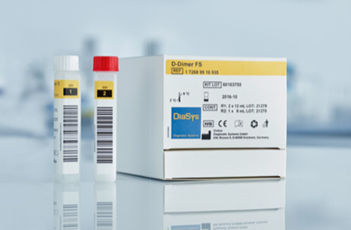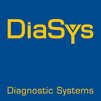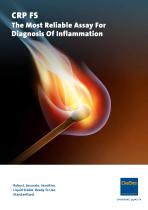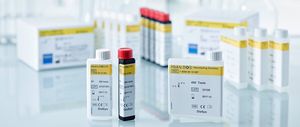
- Laboratory
- Laboratory medicine
- Solution reagent
- DiaSys Diagnostic Systems GmbH

- Company
- Products
- Catalogs
- News & Trends
- Exhibitions
D-dimer reagent FSsolutionclinicalblood sample
Add to favorites
Compare this product
Characteristics
- Type
- solution
- Applications
- clinical, blood sample, immunoturbidimetric
- Tested parameter
- D-dimer, fibrin
Description
During plasma coagulation soluble fibrin is generated. By degradation of cross-linked fibrin, characteristic products called D-dimers are released. Increased D-Dimer levels indicate the activation of coagulation and fibrinolysis processes. Low levels of D-Dimer are mainly used to exclude venous thromboembolism (VTE) such as deep vein thrombosis of the leg (DVT) and pulmonary embolism (PE).
Determination of D-dimer can be used to exclude a suspected DVT or PE with levels below a specific cutoff value
Since neither a reference method nor reference material are available, clinical studies are mandatory to define an assay-specific cut-off and calibrator values
Several studies support the use of a cutoff value of 0.5 FEU µg/L
If D-dimer levels are above the cutoff value imaging techniques as sonograhpy or phlebography are mandatory for a definitive diagnosis of VTE
Specificity for DVT is variable and patient population dependent; adjusted cutoffs were suggested for e.g. elderly patients or for individuals with cancer
Catalogs
Exhibitions
Meet this supplier at the following exhibition(s):

Other DiaSys Diagnostic Systems GmbH products
Calibrators/Controls
Related Searches
- Solution reagent kit
- Diagnostic reagent kit
- Laboratory reagent kit
- Protein reagent kit
- Immunology reagent
- Clinical chemistry reagent
- Clinical chemistry analyzer
- Quality control reagent kit
- Automatic clinical chemistry analyzer
- Benchtop clinical chemistry analyzer
- Clinical reagent kit
- Blood sample reagent kit
- POC reader
- Enzymatic reagent kit
- Blood clinical chemistry analyzer
- Blood POC reader
- Random access biochemistry analyzer
- Clinical chemistry analyzer with ISE
- Serum clinical chemistry analyzer
- Calibration reagent kit
*Prices are pre-tax. They exclude delivery charges and customs duties and do not include additional charges for installation or activation options. Prices are indicative only and may vary by country, with changes to the cost of raw materials and exchange rates.




